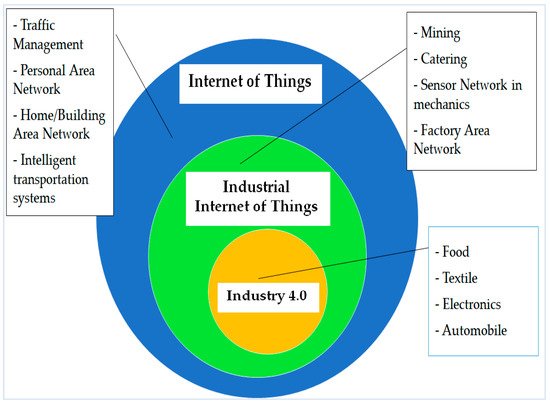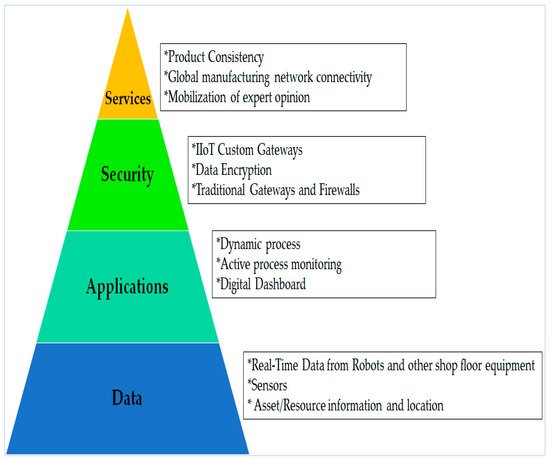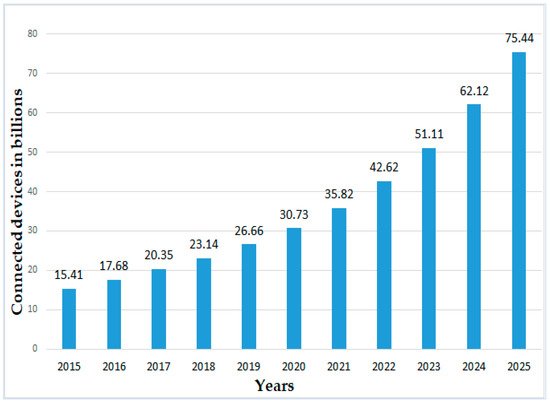There is no doubt that new technology has become one of the crucial parts of most people’s lives around the world. By and large, in this era, the Internet and the Internet of Things (IoT) have become the most indispensable parts of our lives. Recently, IoT technologies have been regarded as the most broadly used tools among other technologies. The tools and the facilities of IoT technologies within the marketplace are part of Industry 4.0. The marketplace is too regarded as a new area that can be used with IoT technologies. One of the main purposes of this paper is to highlight using IoT technologies in Industry 4.0, and the Industrial Internet of Things (IIoT) is another feature revised.
- IoT
- Industry 4.0
- IIoT
- IoT applications
- telemedicine
- COVID-19
- marketplace
1. Introduction
2. Industry 4.0 and the Industrial Internet of Things

2.1. Industry 4.0
| Years | ||||
|---|---|---|---|---|
| 1784 | 1870 | 1969 | Today | |
| Industrial Revolution |
Industry 1.0 Mechanization Steam power Weaving loom |
Industry 2.0 Mass production Assembly line Electrical energy |
Industry 3.0 Automation Computers and electronics |
Industry 4.0 Cyber-physical systems Internet of Things networks |
-
Traffic management and toll collection system
- 2.Real-time vehicle navigation
2.2. Industrial Internet of Things

-
Automated Production
- 2.Maintenance and Safety
- 3.Real-Time Efficiencies
- 4.Workforce-Equipment Connectivity
3. IoT Marketplace

| Years | Utilities | Government | Building Automation | Physical Security | Manufacturing & Natural Resources | Automotive | Healthcare Providers | Retail & Wholesale Trade | Information | Transportation | Total | |
|---|---|---|---|---|---|---|---|---|---|---|---|---|
| Segment | ||||||||||||
| 2018 | 0.98 | 0.4 | 0.23 | 0.83 | 0.33 | 0.27 | 0.21 | 0.29 | 0.37 | 0.06 | 3.96 | |
| 2019 | 1.17 | 0.53 | 0.31 | 0.95 | 0.4 | 0.36 | 0.28 | 0.36 | 0.37 | 0.07 | 4.81 | |
| 2020 | 1.37 | 0.7 | 0.44 | 1.09 | 0.49 | 0.47 | 0.36 | 0.44 | 0.37 | 0.08 | 5.81 | |

IoT Development Market: Exports of Connected Devices
-
Commercial & Industrial Electronics
-
Good growth is projected for sales: 2013–2030 compound annual growth rate (CAGR) = 20%.
-
The next decade (2021–2030) adds the highest amount of devices deployed.
-
-
Consumers
-
In the long term, revenue would see moderated growth: 2013–2030 = 13.8% (CAGR).
-
The user base increased from 2015 to 2020 for connectable devices.
-
New shipping for total compatibility will rise by 12.5% from 2013–2030.
-
-
The dealers post their accessible sensor-flowing information and actuators admit items alongside some hint of their worth and states of utilization.
-
Application designers and data/actuators admit purchasers to peruse or be suggested pertinent sensor data streams/device proprietors just as data intermediaries to interface with. This can be an index or potentially an endorsement instrument.
-
Motivating mechanisms for vendors to afford valuable data and actuators, for example, adaptation per unit amount of data for the actuator to acquire.
-
Directing ongoing data from sensor data sources to all purchasers that are approved dependent on the established understandings (counting installments, procedure arrangements).
-
Steering continuous activation and control signals from approved clients (purchasers) to actuators. Assurance and prestige evaluating and determining components for clients to rate each other. Metering and charging instruments to uphold advertising agreements being steered through the commerce.
-
APIs and SDKs for methodical admittance to different functionalities of the platform data naming and organizing capacities, just as security instruments to channel data.
-
For the Internet of Vehicles (IoVs) to function, monetary transactions must be made between vehicle-to-vehicle networks, vehicle-to-roadside networks, and vehicle-to-infrastructure and pedestrian networks.
-
Smart Agriculture—Real-time crop information is available to farmers and other agricultural supply chain participants using this technology.
-
Smart Health—Data monetization is possible thanks to the wearable IoT (WIoT) devices used by patients, medical imaging, test results, social media, and external patient data that are collected by healthcare systems and patients alike.
This entry is adapted from the peer-reviewed paper 10.3390/s22030730
References
- Tan, L.; Wang, N. Future Internet: The Internet of Things. In Proceedings of the 3rd International Conference on Advanced Computer Theory and Engineering, ICACTE 2010, Chengdu, China, 20–22 August 2010; pp. V5-376–V5-380.
- Ashton, K. Internet of Things. Page 1—RFID Journal. Available online: https://www.rfidjournal.com/articles/view?4986 (accessed on 2 March 2020).
- Magurano, D. Development of a Scalable Architecture for Industrial Internet of Things. Available online: https://pdfs.semanticscholar.org/9ff6/7ba53c0fbaee90d5d27e43d5958b0ff4872f.pdf (accessed on 30 August 2020).
- Miorandi, D.; Sicari, S.; De Pellegrini, F.; Chlamtac, I. Internet of things: Vision, applications and research challenges. Ad Hoc Netw. 2012, 10, 1497–1516.
- Lampropoulos, G.; Siakas, K.; Anastasiadis, T. Internet of Things in the Context of Industry 4.0: An Overview. Int. J. Entrep. Knowl. 2019, 7, 4–19.
- Perera, C.; Liu, C.H.; Jayawardena, S.; Chen, A.M. A Survey on Internet of Things from Industrial Market Perspective. IEEE Access 2014, 2, 1660–1679.
- Wang, S.; Wan, J.; Li, D.; Zhang, C. Implementing Smart Factory of Industrie 4.0: An Outlook. Int. J. Distrib. Sens. Netw. 2016, 12, 3159805.
- Lin, K.; Wang, W.; Bi, Y.; Qiu, M.; Hassan, M.M. Human localization based on inertial sensors and fingerprints in the Industrial Internet of Things. Comput. Netw. 2016, 101, 113–126.
- Jing, Q.; Vasilakos, A.V.; Wan, J.; Lu, J.; Qiu, D. Security of the Internet of Things: Perspectives and challenges. Wirel. Netw. 2014, 20, 2481–2501.
- Blanchet, M.; Rinn, T.; Thaden, G.; Thieulloy, G. Industry 4.0. The New Industrial Revolution. How Europe Will Succeed. Hg V Roland Berg. Strategy Consult; GmbH Münch. Abgerufen Am 1105 2014 Unter: Munich, Germany, 2014.
- Aazam, M.; Zeadally, S.; Harras, K.A. Deploying Fog Computing in Industrial Internet of Things and Industry 4.0. IEEE Trans. Ind. Inform. 2018, 14, 4674–4682.
- Wollschlaeger, M.; Sauter, T.; Jasperneite, J. The Future of Industrial Communication: Automation Networks in the Era of the Internet of Things and Industry 4.0. IEEE Ind. Electron. Mag. 2017, 11, 17–27.
- Mahmoodpour, M.; Lobov, A.; Lanz, M.; Makela, P.; Rundas, N. Role-based visualization of industrial IoT-based systems. In Proceedings of the 14th IEEE/ASME International Conference on Mechatronic and Embedded Systems and Applications, MESA 2018, Oulu, Finland, 2–4 July 2018.
- SlideModel. Industry 4.0 PowerPoint Template. Available online: https://slidemodel.com/templates/industry-4-0-powerpoint-template/ (accessed on 16 March 2020).
- Lee, J.; Bagheri, B.; Kao, H.A. A Cyber-Physical Systems architecture for Industry 4.0-based manufacturing systems. Manuf. Lett. 2015, 3, 18–23.
- Lasi, H.; Fettke, P.; Kemper, H.G.; Feld, T.; Hoffmann, M. Industry 4.0. Bus. Inf. Syst. Eng. 2014, 4, 239–242. Available online: https://link.springer.com/article/10.1007/s12599-014-0334-4#auth-1 (accessed on 1 May 2020).
- Zhong, R.Y.; Xu, X.; Klotz, E.; Newman, S.T. Intelligent Manufacturing in the Context of Industry 4.0: A Review. Engineering 2017, 3, 616–630.
- Batista, N.C.; Melício, R.; Mendes, V.M.F. Services enabler architecture for smart grid and smart living services providers under industry 4.0. Energy Build. 2017, 141, 16–27.
- Zhao, F.; Sun, Z.; Jin, H. Topic-centric and semantic-aware retrieval system for internet of things. Inf. Fusion 2015, 23, 33–42.
- Liu, J.; Yan, Z.; Yang, L.T. Fusion–An aide to data mining in Internet of Things. Inf. Fusion 2015, 23, 1–2.
- Kalsoom, T.; Ahmed, S.; Rafi-ul-Shan, P.M.; Azmat, M.; Akhtar, P.; Pervez, Z.; Imran, M.A.; Ur-Rehman, M. Impact of IOT on Manufacturing Industry 4.0: A new triangular systematic review. Sustainability 2021, 13, 12506.
- Sanchez, L.M.; Nagi, R. A review of agile manufacturing systems. Int. J. Prod. Res. 2001, 39, 3561–3600.
- Dallasega, P.; Rauch, E.; Linder, C. Industry 4.0 as an enabler of proximity for construction supply chains: A systematic literature review. Comput. Ind. 2018, 99, 205–225.
- Kamble, S.S.; Gunasekaran, A.; Sharma, R. Analysis of the driving and dependence power of barriers to adopt Industry 4.0 in Indian manufacturing industry. Comput. Ind. 2018, 101, 107–119.
- Gottge, S.; Menzel, T.; Forslund, H. Industry 4.0 technologies in the purchasing process. Ind. Manag. Data Syst. 2020, 120, 730–748.
- Rahim, M.A.; Rahman, M.A.; Rahman, M.M.; Asyhari, A.T.; Bhuiyan, M.Z.; Ramasamy, D. Evolution of IOT-enabled connectivity and applications in Automotive Industry: A Review. Veh. Commun. 2021, 27, 100285.
- Javaid, S.; Sufian, A.; Pervaiz, S.; Tanveer, M. Smart Traffic Management System using internet of things. In Proceedings of the 20th International Conference on Advanced Communication Technology, ICACT 2018, Chuncheon, Korea, 11–14 February 2018.
- Sumia, L.; Ranga, V. Intelligent traffic management system for prioritizing emergency vehicles in a smart city. Int. J. Eng. 2018, 31, 278–283.
- Pyykonen, P.; Laitinen, J.; Viitanen, J.; Eloranta, P.; Korhonen, T. IOT for intelligent traffic system. In Proceedings of the IEEE 9th International Conference on Intelligent Computer Communication and Processing, ICCP 2013, Cluj-Napoca, Romania, 5–7 September 2013.
- Muthuramalingam, S.; Bharathi, A.; Kumar, S.R.; Gayathri, N.; Sathiyaraj, R.; Balamurugan, B. Iot based intelligent transportation system (iot-its) for global perspective: A case study. In Intelligent Systems Reference Library; Springer Science and Business Media LLC: Berlin/Heidelberg, Germany, 2019; Volume 154.
- Afzal, B.; Umair, M.; Asadullah Shah, G.; Ahmed, E. Enabling IOT platforms for social IOT applications: Vision, feature mapping, and challenges. Future Gener. Comput. Syst. 2019, 92, 718–731.
- Nasr, E.; Kfoury, E.; Khoury, D. An IOT approach to vehicle accident detection, reporting, and Navigation. In Proceedings of the IEEE International Multidisciplinary Conference on Engineering Technology, IMCET 2016, Beirut, Lebanon, 2–4 November 2016.
- Raj, J.T.; Sankar, J. IOT based Smart School Bus Monitoring and Notification System. In Proceedings of the IEEE Region 10 Humanitarian Technology Conference, R10-HTC 2017, Dhaka, Bangladesh, 21–23 December 2017.
- Drath, R.; Horch, A. Industrie 4.0: Hit or Hype? . IEEE Ind. Electron. Mag. 2014, 8, 56–58.
- Mondal, D. The Internet of Thing (IoT) and Industrial Automation: A future perspective. World J. Model. Simul. 2019, 15, 140–149.
- Sreenivasulu, R.; Chalamalasetti, S.R. Applicability of Industrial Internet of Things (IIoT) in Lean Manufacturing: A brief Study. Prod. Sched. 2019, 10, 22–26. Available online: https://www.researchgate.net/publication/337286599_Applicability_of_Industrial_Internet_of_Things_IIoT_in_Lean_Manufacturing_A_brief_Study (accessed on 16 December 2021).
- Harrell, C. The Internet of Things and Control System Architecture. Available online: http://blog.aac.advantech.com/the-internet-of-things-and-control-system-architecture/ (accessed on 1 July 2020).
- Xu, L.D.; He, W.; Li, S. Internet of Things in Industries: A Survey. IEEE Trans. Ind. Inform. 2014, 10, 2233–2243.
- Capello, F.; Toja, M.; Trapani, N. A Real-Time Monitoring Service based on Industrial Internet of Things to manage agrifood logistics. In Proceedings of the 6th International Conference on Information Systems, Logistics and Supply Chain ILS Conference, Bordeaux, France, 1–4 June 2016.
- Caesarendra, W.; Pappachan, B.; Wijaya, T.; Lee, D.; Tjahjowidodo, T.; Then, D.; Manyar, O. An AWS Machine Learning-Based Indirect Monitoring Method for Deburring in Aerospace Industries towards Industry 4.0. Appl. Sci. 2018, 8, 2165.
- Hiter, S. Industrial Internet of Things (IIoT) Market Size & Forecast. 2022. Available online: https://www.datamation.com/trends/industrial-internet-of-things-iiot-market/ (accessed on 16 December 2021).
- Evans, D. The Internet of Things How the Next Evolution of the Internet Is Changing Everything. Cisco Internet Bus. Solut. Group (IBSG) 2011, 1, 1–11. Available online: https://www.cisco.com/c/dam/en_us/about/ac79/docs/innov/IoT_IBSG_0411FINAL.pdf (accessed on 10 February 2021).
- Afshar, V. HuffPost Is Now a Part of Verizon Media. Available online: https://www.huffpost.com/entry/cisco-enterprises-are-leading-the-internet-of-things_b_59a41fcee4b0a62d0987b0c6 (accessed on 14 June 2020).
- Statista Research Department. IoT: Number of Connected Devices Worldwide 2012–2025. Available online: https://www.statista.com/statistics/471264/iot-number-of-connected-devices-worldwide/ (accessed on 10 February 2020).
- Patil, P.; Tawade, P.; Samudre, S.; Mali, S.; Pardeshi, S. Survey on Internet of Things (IoT): Tools and Technologies. Int. J. Sci. Res. Comput. Sci. Eng. Inf. Technol. (IJSRCSEIT) 2018, 3, 1108–1112. Available online: http://ijsrcseit.com/CSEIT1833352 (accessed on 3 April 2021).
- Heutger, M. A Shared Journey: Customer-Centric Innovation-Huawei Case Studies. Huawei Enterprise. Available online: https://e.huawei.com/en/case-studies/global/2017/201709070922 (accessed on 16 December 2021).
- Cisco. Solutions-Cisco IOT Helps Nissan Transform Car Production Operations. Cisco. Available online: https://www.cisco.com/c/en/us/solutions/collateral/internet-of-things/nissan-motors-case-study.html (accessed on 16 December 2021).
- Gartner Gartner Says 5.8 Billion Enterprise and Automotive IoT Endpoints Will Be in Use in 2020. Available online: https://www.gartner.com/en/newsroom/press-releases/2019-08-29-gartner-says-5-8-billion-enterprise-and-automotive-io (accessed on 3 April 2020).
- Welbourne, E.; Battle, L.; Cole, G.; Gould, K.; Rector, K.; Raymer, S.; Balazinska, M.; Borriello, G. Building the Internet of Things Using RFID: The RFID Ecosystem Experience. IEEE Internet Comput. 2009, 13, 48–55.
- Presser, M.; Gluhak, A. The Internet of things: Connecting the real world with the digital world. Eurescom Message—The Magazine for Telecom Insiders. 2009, Volume 2. Available online: http://www.eurescom.eu/message (accessed on 1 January 2021).
- Ray, P.P. A survey on Internet of Things architectures. J. King Saud Univ.-Comput. Inf. Sci. 2018, 30, 291–319.
- Frost & Sullivan Best Practices Award. Radio-Frequency Identification for Retail Self Checkouts—Europe. 2019, pp. 1–19. Available online: https://www.nordicid.com/wp-content/uploads/Frost-Sullivan-Nordic-ID-New-Product-Innovation-2019-report.pdf (accessed on 10 December 2021).
- Yang, C.; Shen, W.; Wang, X. Applications of Internet of Things in manufacturing. In Proceedings of the IEEE 20th International Conference on Computer Supported Cooperative Work in Design, CSCWD 2016, Nanchang, China, 4–6 May 2016.
- Industrial Internet of Things Market Size Report. 2021–2028. Available online: https://www.grandviewresearch.com/industry-analysis/industrial-internet-of-things-iiot-market (accessed on 16 December 2021).
- Shen, W.; Norrie, D.H. Agent-Based Systems for Intelligent Manufacturing: A State-of-the-Art Survey. Knowl. Inf. Syst. 1999, 1, 129–156.
- Li, X.; Li, D.; Wan, J.; Vasilakos, A.V.; Lai, C.-F.; Wang, S. A review of industrial wireless networks in the context of Industry 4.0. Wirel. Netw. 2015, 23, 23–41.
- Lund, D.; Carrie, C.; Turner, V.; Morales, M. Worldwide and Regional Internet of Things (IoT) 2014–2020 Forecast: A Virtuous Circle of Proven Value and Demand. IDC Analyze the Future, 1–27. Available online: http://branden.biz/wp-content/uploads/2017/06/IoT-worldwide_regional_2014-2020-forecast.pdf (accessed on 10 January 2020).
- Morelli, B. IoT Market Overview. 2018. Available online: https://www.gsaglobal.org/wp-content/uploads/2019/05/Bill-Morelli-GSA-Silicon-Summit-IoT-Market-Overview-IHS-Markit-4.9.18.pdf (accessed on 17 September 2021).
- Krishnamachari, B.; Power, J.; Shahabi, C.; Kim, S.H. IoT Marketplace: A Data and API Market for IoT Devices; University of Southern California: Los Angeles, CA, USA, 2017.
- Saputhanthri, A.; Alwis, C.D.; Liyanage, M. Emergence of Blockchain Based IOT Marketplaces. Available online: https://www.researchgate.net/profile/Madhusanka-Liyanage/publication/350835689_Emergence_of_Blockchain_based_IoT_Marketplaces/links/6080a4c8907dcf667bb5ae4f/Emergence-of-Blockchain-based-IoT-Marketplaces.pdf (accessed on 19 December 2021).
